Thinking of Buying a C2 Corvette? Here’s What You Need to Know
When most of us think of the Corvette, we immediately envision the 1963 Split-Window coupe. It’s perfectly reasonable that your mind would gravitate to this car, despite it being nearly sixty-years old and not an example of the current mid-engine sports car. In all the iterations of the Corvette that have come and gone since Harley Earl introduced us to the original Corvette in January 1953, there has never been a car more sought after, more revered, more ICONIC, than the second-generation Corvette. What’s interesting about this car is that, despite its popularity in the mid-1960s, the second-generation Corvette holds the record for the fewest number of production years of any generation Corvette that has come into being. It’s also interesting to note that the most valuable examples of the C2 Corvette live sort of like “bookends” at the start and finish of second-generation production.
On one-hand, you have the legendary 1963 Split-Window coupe ushering in the new era of Corvette. Because the car was built with a split window for its maiden year, combined with the fact that the split-window was abandoned after just a single year of production, a 1963 Split-Window Corvette coupe can command big dollars from would-be consumers.
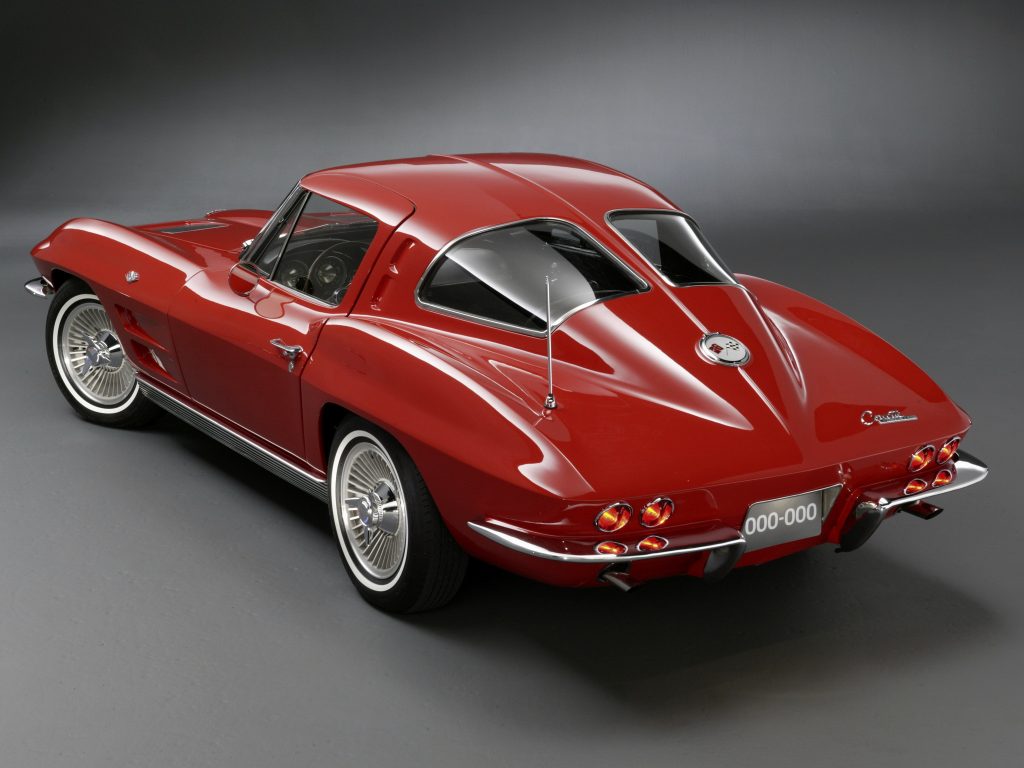
At the other end of the spectrum, we have the 1967 L88 Corvette. Considered the “pinnacle of all Corvettes,” these cars command top-dollar whenever they change hands. Of course, the sale of an L88 Corvette is an extremely rare find. If you are lucky enough to find one for sale, assuming its an actual L88 and not a knock-off/clone, you can expect to see sales in the range of one-to-four million dollars.
Introducing the Second-Generation Corvette
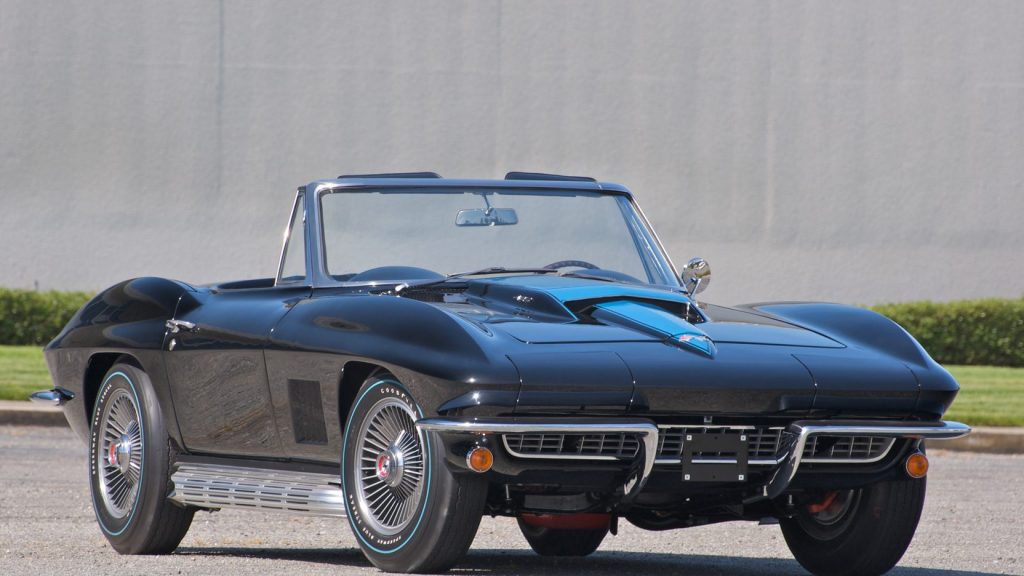
There is no doubt that the second-generation Corvette was a revolutionary departure from the original “solid-axle” C1 Corvette. This new Corvette featured fully-independent suspension and a chassis that evolved from the 1959 Stingray concept race car originally envisioned by Brock Yates and fully realized by Bill Mitchell, Zora Arkus-Duntov and Larry Shinoda.
The iconic C2 Corvettes – from 1963 to 1967 – solidified the brand as a serious contender on the world racing stage (even though it was developed in an era when GM was actively participating in the AMA racing ban). The second-generation Corvettes gave us disc brakes, independent suspension, revolutionary engine development, including the introduction of big-block power, and advances in technology on both the interior and exterior of the car. More than that, the design of the C2 Corvettes was simply beautiful “art-in-motion.”
Year-by-Year – What Are the Differences?
1963 Corvette
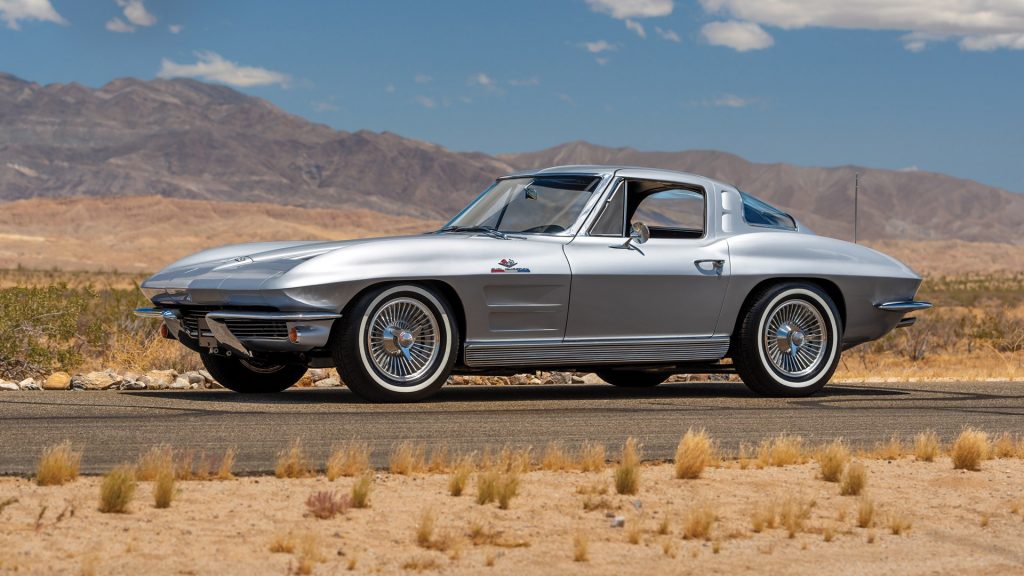
While nobody could have predicted it then, the C2 Corvette has become one of the most desirable Corvettes of them all, and none more so than the 1963 model year. The original 1963 Sting Ray Coupe is considered to be one of the most collectible Corvettes of all time because of its unique split rear window design. Surprisingly, many split-window coupes were modified by customizers, some of whom replaced the small, individual panes of glass with a one-piece window made of Plexiglass. Even more surprising is that Chevy began offering replacement one-piece windows through its dealerships. As a result, a good many 1963 Corvette coupes lost a considerable amount of their collector value.
The Sting Ray had a newly designed chassis that featured a shorter wheelbase and a faster “Ball-Race” steering (a name that was developed by the ad copy (advertisement) writers in 1963,) both of which attributed to providing the car with improved maneuverability and handling.
A number of items did carry over from the C1 Corvette. This included all four of the small-block, 327C.I. V-8 engines, a trio of transmissions, and six different axle ratios. The engines that were offered for the 1963 Corvette included three carbureted versions; a 250-, 300-, and 340-horsepower variants, as well as a 360-horsepower fuel-injected engine. The car’s standard three-speed transmission also carried over from the 1962 model year and remained available in 1963 though neither it nor the optional Powerglide automatic transmission were installed into many second-generation Corvettes. Instead, the preferred gearbox continued to be the Borg-Warner manual four-speed transmission.
The 1963 Corvette came equipped (standard) with wider, four-wheel cast-iron 11-inch drum brakes, which provided a more effective braking area, which, in turn, produced shorter stopping distances. Optionally, consumers had the ability to order special, sintered-metallic linings that were segmented for better cooling. They also had the option of ordering finned aluminum (“Al-Fin”) drums, which not only provided faster heat dissipation, but also less unsprung weight. Optional power assist was available for both braking packages.
For the 1963 model year, Zora Arkus-Duntov had made it possible to turn any Corvette into a racer by informing consumers which options to order when buying their cars. When he and Bill Mitchell completed the design and development of the second-generation Corvette, he had become more determined than ever to ensure that anyone who wanted to race his sophisticated new Sting Ray should have the ability to do so. It was with this rationale in mind that he developed RPO Z06 – a new competition-oriented package. Corvettes equipped with the Z06 option received the top-line Al-Fin power brakes with sintered metallic brake linings, a heavy-duty front stabilizer bar, stronger shocks, much stiffer springs, a dual master cylinder, and a long-distance 36.5-gallon fuel tank.
1964 Corvette
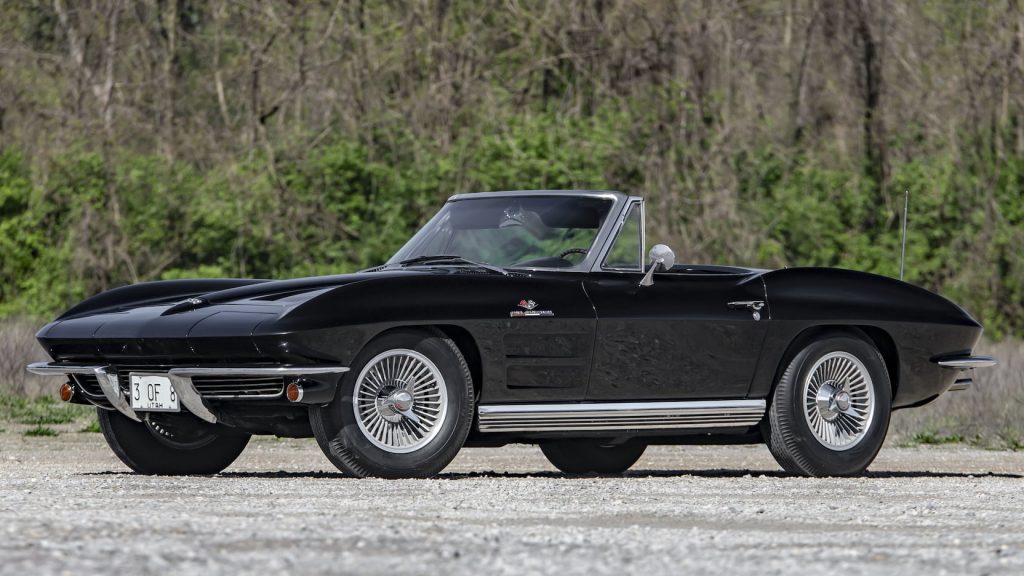
The 1964 Corvette featured a handful of functional changes and a few minor cosmetic refinements, but for the most part, it retained much of the ingenuity and design cues that had contributed to the second-generation Corvette’s success the previous year.
Most of the styling refinements that were made to the exterior of the 1964 model were subtle. The most notable change involved the replacement of the rear split-window that had been introduced in 1963. The split-window was abandoned completely by General Motors in 1964, replaced instead by a rear window that was constructed of a single piece of glass. Another notable change that was made to the body lines on the 1964 model involved the removal of the faux hood vents that had adorned the 1963 model. Although the vents themselves were stripped from the design, the recessed areas where they had been mounted remained, giving the 1964 Corvette hood a distinctive look all its own. The coupe’s rear pillar panel vents, which had been cosmetic just a year before, was now made fully functional, but only on the driver’s side. The car’s rocker panel trim was replaced by a new panel that featured a black divider that ran the length of the car. The car’s wheel covers were simplified. The fuel filler neck cover/deck emblem was redesigned to include concentric circles around its crossed-flags insignia.
The drivetrain choices remained pretty much the same as they had in 1963: four 327 cubic inch diameter V-8 engines were mated to either a three-speed, a four-speed manual transmission, or the Powerglide automatic transmission. Of these engines, the two least-powerful engines returned with 250 and 300 horsepower at a 10.5:1 compression ratio. The high-performance engines, however, did receive some noteworthy upgrades. To start, the carbureted engine was improved upon with the introduction of a Holley carburetor instead of the original base engine’s Carter unit. The engine, now fed through the big four-barrel Holley carburetor duration camshaft that helped to produce 365 horsepower. The fuel-injected variant gained an additional fifteen horsepower over the previous year. Now rated at 375 horsepower (at 6,600 rpm), this last engine introduced a re-profiled camshaft with greater life and a longer dwell, as well as improved ports and valve gear.
Starting with the 1964 model year (and lasting thru 1967), some Corvette bodies were supplied by Dow-Smith (located in Ionia, Michigan.) Dow-Smith is a division of the A.0. Smith Company. Also, while it is true that the C2 Corvette did introduce the factory installation of bodyside exhaust pipes, they were not a factory option until 1965. Every Corvette (coupe or convertible) that is titled as a 1963 or 1964 should only have exhaust coming out of the rear of the car. Any other configuration is an aftermarket add and may hurt the collectability of that particular Corvette.
Positraction was not a standard option at the onset of the C2. While commonplace in Corvettes today, positraction was still an option in 1964 – though a very affordable one. More than 80 percent of all 1964 Corvettes included the option. A “Special Sintered Brake Package” option was introduced in the 1964 Corvette. It was specifically aimed at performance-focused drivers and required a number of other options – including the Positraction rear axle – before these brakes could even be installed. Only 29 Corvettes included this option in 1964.
1965 Corvette
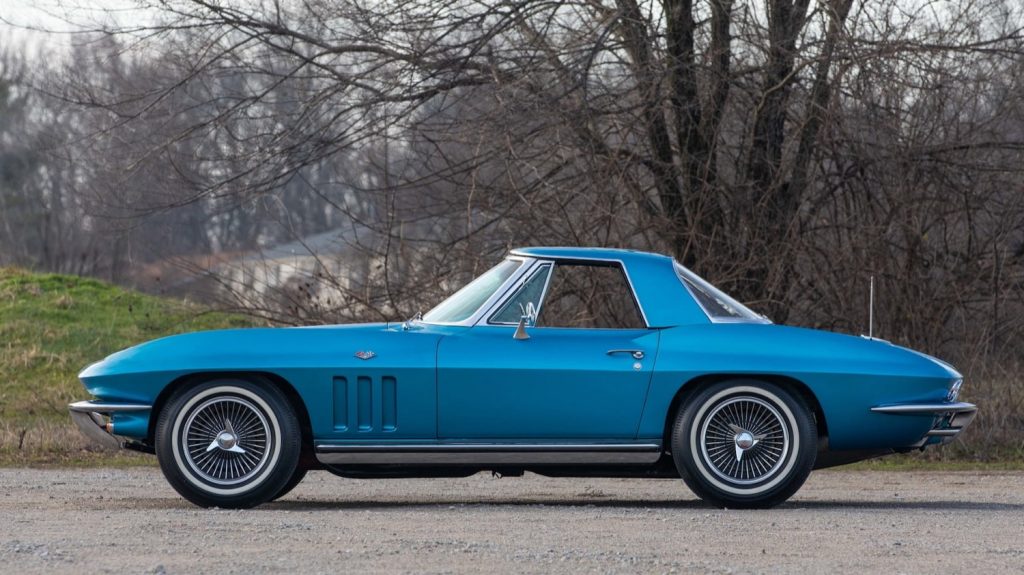
The focus for the 1965 Corvette was focused on some significant mechanical upgrades that would vastly improve the Corvette’s already impressive handling and drivability.
The most notable change to the outward appearance of the car was the removal of the former scoop indentations, which had carried over in the 1964 model (after the faux hood scoops were removed from the 1963 design.) The new hood, which was now a single, smooth surface, became one of the major differentiating characteristics of the 1965 model year. Additionally, the front fenders were redesigned to feature a trio of working exhaust vents (which replaced the previous model’s non-functional horizontal “speedline” coves.) Another notable design change involved refinements to the front grill. For the 1965 model treatment, the inner, horizontal grill bars were painted black, but the outer grill remained a bright chrome color, making the overall design unique to the 1965 Corvette. Lastly, the wheel covers and rocker-panel moldings were re-designed for the 1965 model year. The optional knock-off wheel covers now featured a dark gray paint color between the fins.
The interior of the car also received some minor design refinements as well. In the driver’s dashboard, all of the instrument displays were redesigned to include flat black faces. The areas around the radio and speaker bezel were painted instead of utilizing vinyl coverings, which had been standard on previous models. A more notable improvement involved changes in the design of the car’s driver and passenger seats. The new seating surfaces were designed to be slightly larger and more supportive, and the seatbacks were encased in hard plastic backing shells. The inner door panels were redesigned and now included fully integrated armrests. Lastly, the interior received new seat belt retractors, a feature that was never before been seen in a Corvette.
Mechanically, the brakes on the 1965 Corvette featured a four-piston design with two-piece calipers mated to a newly designed brake rotor which utilized cooling fins. The cooling fins helped to dissipate the massive amount of heat being generated during hard braking. The car came equipped with all new semi-metallic brake pads. These pads were designed to remain in constant contact with the brake rotors which aided in keeping the braking surfaces on the rotor free from rust and debris (both of which cause pitting and diminish the lifespan of any brake rotor.) Another significant improvement and mechanical milestone arrived midway through the 1965 model year. Officially titled the Mark IV, Chevrolet introduced a new, optional, big-block V-8 engine for the first time in a production Corvette. The engine featured 11:1 compression, impact-extruded alloy pistons with chrome rings, solid lifters, a bigger carburetor (and corresponding double-snorkel air cleaner), and an oversized oil pump, all of which helped make this more radical Mark IV engine capable of producing an impressive 425 horsepower. Aside from the late-entry Mark IV, several other engines had remained available for the 1965 model year including a 375 horsepower, 327 cubic-inch small-block V8 that came equipped with fuel injection. Additionally, GM introduced the L79 small block, which was essentially an L76 327 engine featuring a slightly milder hydraulic cam in place of the solid-lifter stick. Operating on an 11:1 compression ratio, the L79 engine was rated at 350 horsepower, and was deemed nearly identical to the L76 on the outside with its chromed air cleaner and finned cast-aluminum valve covers.
1966 Corvette
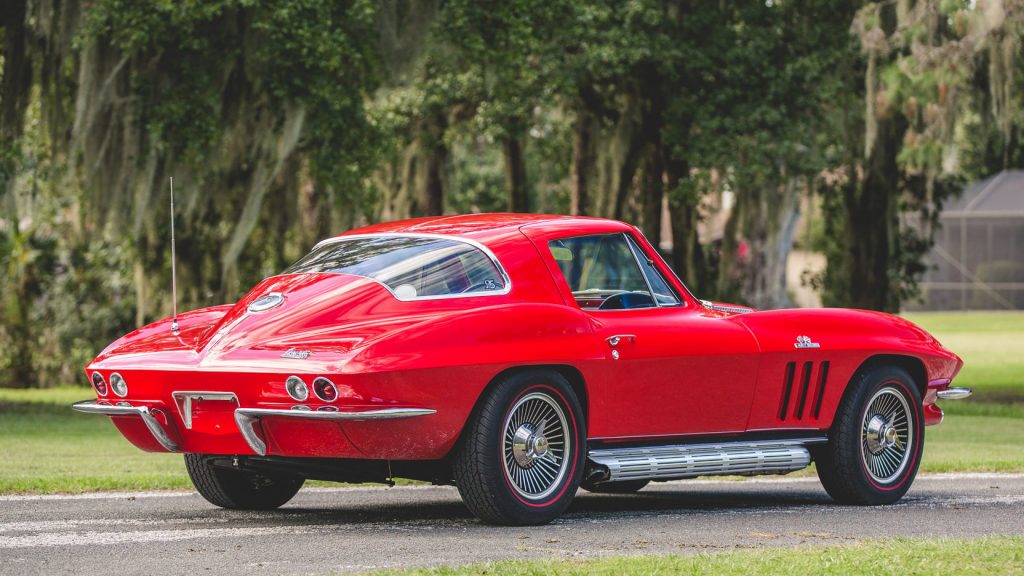
For the 1966 Corvette, the new 427 big-block engine came in two forms: the relatively mild L36, which featured a hydraulic-cam and produced 390 horsepower on 10.25:1 compression, and the truly awesome L72, a 425 horsepower engine with 11:1 compression, larger intake valves, a bigger Holley four-barrel carburetor on an aluminum manifold, mechanical lifters, and four-hole (instead of two-hole) main bearing caps. Corvettes equipped with this type of engine received a special bubble hood first seen on the 1965 Corvettes equipped with the 396 cubic inch engine. Although initially listed as a 450hp engine, the solid lifter 427ci engine’s rating was later reduced to 425hp shortly after its introduction for reasons unknown. Similarly, the 390 horsepower engine was initially rated at 400 horsepower. When the official ratings were reduced, the decision to make this change was purely administrative and was not the result of any changes made to the engines. The small-block engine options were reduced from five to two for the 1966 model year, with only the 300-horsepower (L75) and 350-horsepower (L79) versions remaining available to prospective consumers.
There were minor modifications made to the 1966 Corvette’s appearance. For one, the Sting Ray’s front end was mildly altered with the introduction of an “egg-crate” grille insert which replaced the previously installed horizontal bars. Restyled wheel covers were introduced along with an all-new rocker trim. Also, the coupe lost its roof-mounted extractor vents, which had proven to be inefficient in earlier model years. Lastly, less notable upgrades like the addition of “Corvette Sting Ray” scripts to the hood and the introduction of standard backup lights were introduced.
The interior went largely unaltered from 1965 Corvette. The interior electric ventilation system was dropped, extra pleats were added to the Sting Ray’s bucket seats, chrome door pull handles were introduced, headrests were made optional, and a vinyl-covered foam headliner replaced the previously used fiberboard.
1967 Corvette
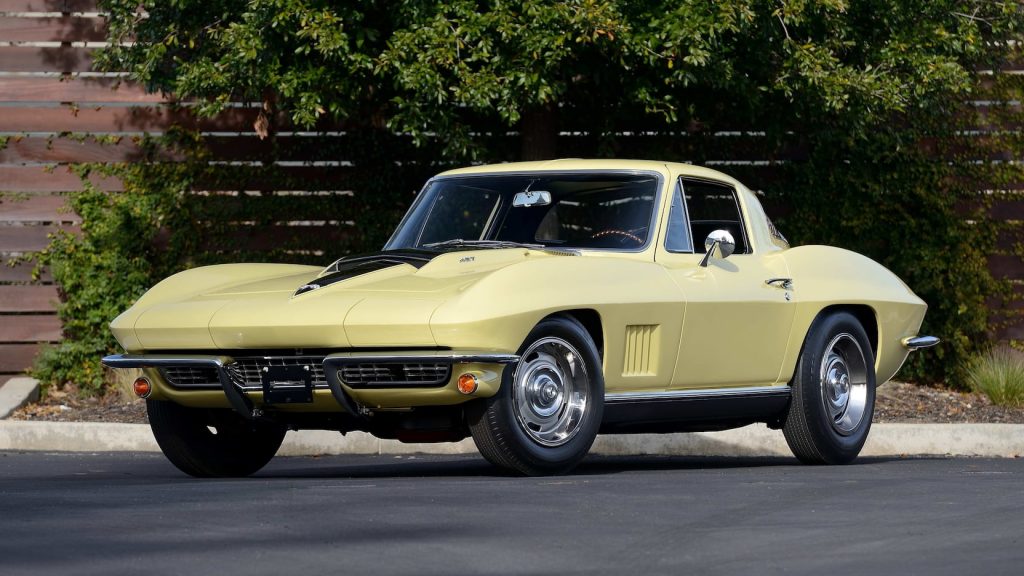
The 1967 Corvette proved to be the most sophisticated of all the Sting Ray models. The second-generation Sting Ray had been refined to its evolutionary limits – the result of which was a car that was clearly the best model of its five-year run. Much of the trim (including hood script emblems and fender flags) were removed. The front fenders now featured five smaller air vents in place of the three larger ones that had originally been introduced in 1965. The rocker panels were given a flat finish without any ribbing, which gave the car a lower, smoother outward appearance. In the rear of the car, a new, single backup light was introduced (unique only to the 1967 model) over the license plate. Lastly, the earlier models’ wheel covers were replaced with slotted six-inch Rally wheels with chrome beauty rings and lug nuts that were concealed behind small chrome caps.
The 1967 Corvette only received minor updates to its interior. The upholstery was revised and the seats were a new design. The hand brake (parking brake) was relocated from beneath the dashboard to between the seats – a Corvette first. The lock buttons were moved further forward and an attaching screw was added at the rear. Perhaps the most notable change to the 1967 Corvette’s interior was the removal of the passenger hand-hold above the glovebox, a feature that had been part of the Corvette since 1958.
As with the previous year, the two small-block V-8 engines returned, as did the 390 horsepower big-block, though this last engine was fitted under a redesigned hood scoop. The biggest changes involved the pair of big-block 427 engines, which now produced 400 and 435 brake horsepower respectively, due to the introduction of triple two-barrel carburetors. Like last year’s model, these new 427 cubic inch engines differed in compression ratios – 10.25:1 and 11.0:1 respectively. The latter of these two engines, RPO L71, also included optional specialized aluminum heads (instead of cast iron) and larger-diameter exhaust valves like those included in RPO L89. Based on the already impressive L89 engine, Chevrolet decided to introduce the “ultimate” Corvette engine in 1967 by introducing an engine coded with the designation L88. The L88 engine was an immensely powerful production engine and was about as close to a pure racing engine as any Chevrolet had introduced in a commercial vehicle up to that point in time. The L88 equipped Corvette was limited to a mere 20 units.
A blue, “GM Mark of Excellence” label was attached to the back of each 1967 Corvette door above the latch. This initiative was the direct result of General Motor’s quality awareness program. Additionally, safety legislation required a modification of the knock off wheel option. For the 1967 model year, the wheels were changed to a bolt-on, cast alloy style with a clip-on center cap to conceal the lug nuts.
The C2 Buyer’s Guide
Frame Rust/Birdcage Rust
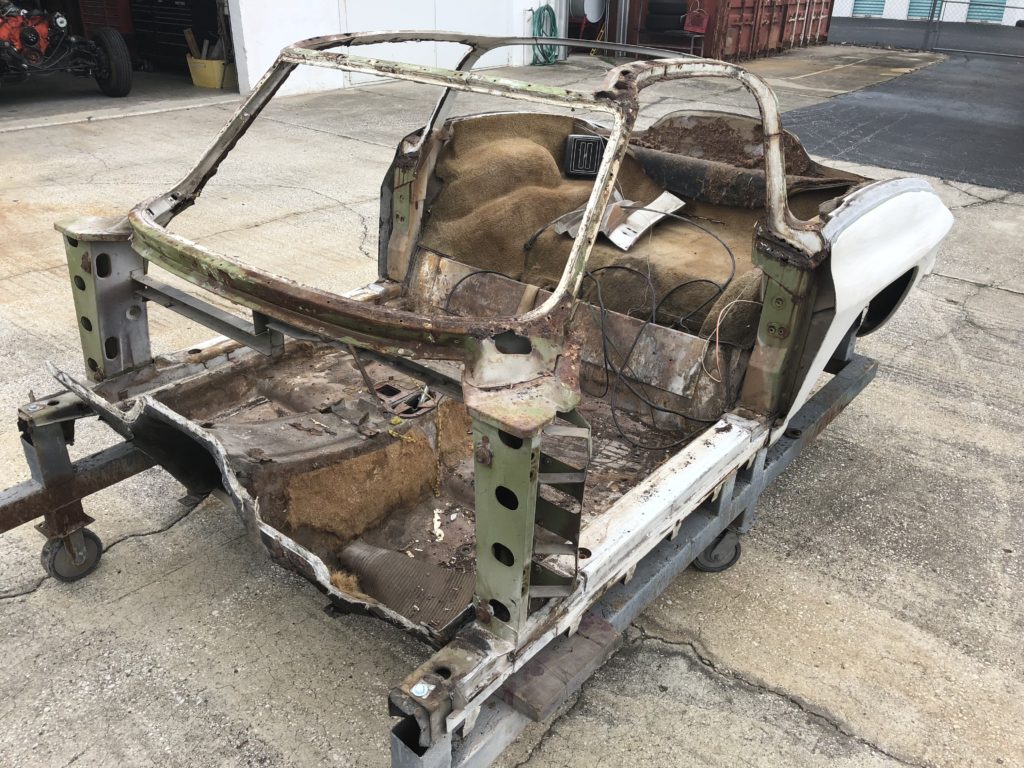
One of the “unseen” problems with a car that includes a fiberglass body is that they don’t rust – on the surface. Why is this a problem? Because the outward appearance of the car may not represent what’s going on inside/beneath the surface. Just because Corvette bodies don’t rust doesn’t mean that their frames won’t. The steelwork on these cars is extensive and is definitely rust-prone, especially on cars from northern climates that may have been exposed to years of salt on icy roadways or cars from areas near the ocean where airborne saltwater may have accelerated the corrosion process.
When evaluating a C2 Corvette, start with an inspection of the undercarriage. Have the car put on a lift so that a thorough examination of the undercarriage can be completed. Remove trim panels where possible and look for potential damage and for frame integrity. Inspect the chassis, the door frames, and the “birdcage” – the area that links the sills, doorposts, screens, and roof bridge assembly. Make sure to take the time to examine each piece closely, looking for rust debris, fatigue around weld points, and overall structural rigidity of the steel itself. On cars equipped with T-tops, look at the center bar that replaces the cross braces at the windows.
Make sure to inspect the trailing arms. They can gather dirt and debris and are prone to rust. Additionally, take the time to perform a visual inspection of the internal side of the body panels as well. Make sure each panel is properly mated to the other, that each sits square and appear to be bonded properly to its appropriate sub-structures. Ensure that all sub-structure assemblies appear to be in good condition, especially at the bottom of the windshield posts, the radiator support, and front body and bumper-support structures.
The chassis is also vulnerable to corrosion, especially in the boxed side rails beneath and behind the doors.
Body Panel Bonding Strips
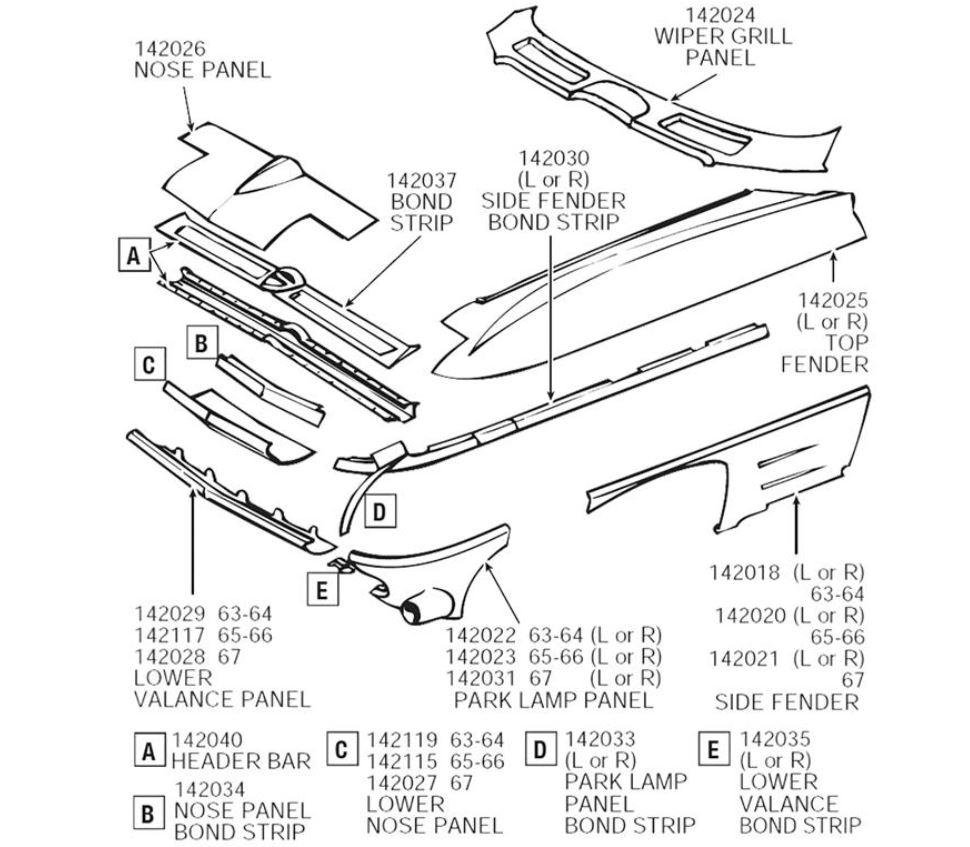
While you’ve got the car up on a lift, take time to inspect the internal side of the car’s fiberglass body panels. Also, take time to inspect the body panel bonding strips. When the fiberglass body of the Corvette is assembled, many of the body pieces are held together via the use of lengths of fiberglass commonly referred to as bonding strips. Inspection of the bonding strips is another easy way to determine if a car has had bodywork done to it. In such cases, the strips holding the panels together will appear mismatched, and/or you’ll see areas where bonding strips may have been removed entirely.
In addition to the bonding strips, look closely at the interior of the body panels. If you see a discrepancy between the fit and finish of the fiberglass, it could be an indicator that the car has had some bodywork done. This doesn’t necessarily mean it’s been in an accident, but it is worth investigating further if your findings do indicate that panels have been removed and replaced.
Body Panel Fitment – Hood, Trunk, Doors, and Fenders
Moving to the exterior of the car, look closely at the gaps between various body panels. Uneven gaps between doors and fenders, fenders and hood, etc., are strong indicators that the car has had bodywork done to it. It is often an indicator that the car has been involved in an accident.
That said, it is equally important to remember that these cars are 50+ years old. Many of the precision standards used in manufacturing today did not exist when these cars were being assembled. It is possible that the individual Corvette you are looking to purchase may have variances in the width of the body panel gaps. It is also possible that, over the course of time, panels have shifted due to less dramatic events – heat expansion (from sitting in the sun), contraction (from exposure to cold), aging of the bonding strips, etc. Anyone or more of these can cause panel fitment to shift over time.
Additionally, the current owner of the car may not know the complete history of the vehicle (especially if he/she is not the original owner.) It is important not to accuse the owner of misconduct as they may be unaware of any bodywork ever being done to the car since it came into their possession. As most owners take great pride in their Corvettes, it is important to remember to address these types of items with a degree of discretion when questioning the history of the car.
Fiberglass Stress Cracks
We mentioned the impact that environmental factors can have on body panel fitment above. The same holds true for the aging of fiberglass. Like all materials, fiberglass is prone to age over time. Due to the chemicals available at the time the early Corvettes were being produced, the ability to seal fiberglass was also limited, meaning it was more prone to pitting and cracking than more contemporary examples of the car.
When inspecting any C2 Corvette, look closely for pitting, cracking, or other imperfections in the fiberglass body. Be thorough and look underneath the lips of the cars wheel wells, along the leading edges of the doors, windshield posts, underneath the rear decklid, etc. Take time to examine every component thoroughly.
Keep in mind that some aging is bound to occur on any car from this era. Even cars stored in climate-controlled environments could show indications of body panel aging. It should definitely not be a deal-breaker. Where caution comes into play is directly related to the number of stress cracks or blemishes that are found during an inspection. Should an inspection reveal the significant deterioration of the car’s body, it could indicate that the car was exposed to the elements for a prolonged period of time. Long exposure to UV radiation, extreme heat and cold, even prolonged exposure to moisture (over years) can lead to the eventual deterioration of the car’s body panels and, as such, it is important to be thorough in your examination of the car.
VIN Numbers and Completeness
These next two items are more subjective to the buyer’s individual preference. However, they are worth considering.
First, verify engine casting numbers, transmission casting numbers, and VIN numbers.
If you are looking for a numbers-matching car or, put another way, an original, unmolested example of a particular Corvette, this will be of particular importance to you. Because so many Corvettes have had engines swapped, replaced, modified, etc., many of the early examples of these cars now feature a powertrain that is different from what originally came in the car. Even if the engine is the same displacement, it could be a crate engine that replaced an engine that failed sometime in the past.
A “numbers matching” car (the VIN and engine serial numbers match) is worth 20-30 percent more than a Corvette that has been altered. It is important to keep this in mind when negotiating a price for your would-be Corvette.
Second, keep in mind that many vintage Corvettes will NOT be numbers-matching, and that’s also completely okay! Number matching Corvettes became a bigger deal as the NCRS (National Corvette Restorers Society) began judging Corvette restorations based on their completeness. Over time, the stigma of a “numbers matching” car became one of the highest judging criteria of that organization.
It is important to remember the reason YOU are purchasing a Corvette. If you are looking for a car strictly to compete in car shows or the like, then having a numbers-matching car may be the way to go. However, if you are looking for a weekend cruiser, or a project car to restore and call your own, then the significance of having a numbers-matching car goes down appreciably. There are plenty of non-numbers matching cars out there that are well-built cars that promise an amazing driving experience that will bring a smile to your face for many years to come.
One item that tends to cause issue/concern among Corvette enthusiasts is coming across a Corvette that has been re-painted a different color. Once again, this is not necessarily a deal-breaker, but color change on a Corvette is a major detractor from the standpoint of re-sale, so it should be taken into consideration prior to purchasing.
Get a Used Car Check
Take time to have the car checked by a reputable mechanic (either at a dealership or a trusted service garage). Ask them to check the vehicle’s fluids, perform a compression test on each of the cylinders, check the brakes, the steering linkage, the cooling, and electrical systems, and the safety restraint/airbag systems to ensure that everything on the car is as it should be. While you’ll probably have already inspected a number of these items yourself, having a trained professional verify your findings will provide you with greater peace of mind before handing over your hard-earned dollars for a used sports car – even one as nice as a Corvette!
Take It For a Test Drive
After you’ve done all of your homework, its time to get your prospective Corvette out on the open road. The test drive will allow you to experience the car in a way that no inspection ever could. It will help you determine whether or not the car is a good fit for you as a driver. Even a perfectly maintained Corvette isn’t going to be of value (or enjoyment) to you if you aren’t comfortable driving it. For some perspective owners, a first-generation Corvette might sit too-low-to-the-ground, or the cockpit might seem too compact (keep in mind these cars are all two-seat sports car with no backseat and limited storage space, especially in the convertible models.) For others, the ride may be too harsh, or the exhaust and/or road noise might be too loud.
It is important to remember that the C2 Corvette evolved from 1963 to 1967, especially in regards to engine horsepower/output and overall performance capabilities. We recommend you drive several different examples – while they’re all based on the same platform, you’ll be surprised how different each year is from the others.
Also, the test drive is another means of checking the car’s operability. When driving the car, don’t allow the passenger (who will probably be the car’s current owner) to spend the entire drive talking at you or with you. It is important that you listen to the car. Pay attention to any clunks, engine, or transmission noises. Also, take enough time to really put the car thru its paces. Observe if the car wants to pull to the left or right. Be intentional about testing the brakes and the steering. If it is a manual transmission, pay attention to when the clutch begins to catch – if it’s got a high clutch pedal, it could indicate that the clutch is worn out. Look for smoke coming from the exhaust or beneath the hood and pay attention to any unusual smells – such as burning oil or engine coolant.
Be Patient – Take Your Time!
For most of us, buying a Corvette is an emotional experience. It’s a promise that many of us make to ourselves when we see our first Corvette that “someday I’m going to have one of my own.”
If you are in the market to buy your first (or next) Corvette – CONGRATULATIONS! This is an exciting time for you, and it is understandable that you’d want to find the “perfect” car to bring home and have forevermore. However, you must practice patience when shopping for a used Corvette. Just as you dream of countless hours enjoying the back countryside and the open road, the people who purchased the car you are now looking at dreamed the same dreams. As such, finding the right Corvette is a little different than buying a “daily driver” that you’d use for your commute back and forth to work. These cars are driven harder, faster, and often with less regard to the wear and tear than to the exhilarating experience of flying thru a sharp turn just a little too fast.
Because of this, you’ll want to follow all the steps we outlined in this article. You’ll want to keep emotion out of the decision-making process as much as is humanly possible. That’s not to say you shouldn’t enjoy the experience, but be informed and purchase a Corvette that passes all these search criteria so you’ll have as much enjoyment with your Corvette after you make the purchase as you did finding it in the first place. It is also worth noting that shopping for a Corvette can be a lot of fun! You’ll definitely get to drive some amazing cars along the way…and here’s where you should embrace and enjoy the journey of finding the “perfect Corvette.” If nothing else, you can be certain that when you do finally make your big purchase, you’ll have found a Corvette that is perfect for YOU.
Anticipate Ownership Costs
There is one other item worth considering when purchasing an almost 60-year old Corvette. This car is likely not going to be your primary means of transportation and, as such, this car will not be driven daily. Make sure you’ve got sufficient space to store your automobile. Additionally, you’ll want to contact your insurance provider to determine the cost of insuring a Corvette. Keep in mind that the amount of anticipated mileage to be driven each year will influence the cost of insuring the car. Lastly, remember that even the best-maintained Corvettes will require some amount of maintenance, so evaluate the costs associated with vehicle maintenance and verify the affordability of the car before committing to its purchase.
What Are These Cars Worth?
The used collector’s car market is a difficult thing to measure in terms of vehicle values. Every sports car on the market today will have significant swings in its market value based on a number of varying factors including long-term reliability, availability, and demand of next-generation models (this one has a huge impact on Corvettes of all generations), the rarity of particular options within a particular series of cars (such as paint color/interior color combinations, included options, limited edition models, etc.)
When trying to evaluate what a used Corvette’s “worth” is, there are a number of approaches that can be taken. Fortunately, the internet has taken some of the mystery out of the valuation process because it allows would-be consumers the opportunity to look at cars across the nation (and even around the world) and compare prices in real-time. It is a worthwhile exercise to get online and spend time shopping at reputable automotive websites such as AutoTrader, CarGurus, Craigslist, and the like. These websites will allow you to narrow down your search to a specific model, geographic area or even by specific options that are important to you as a consumer, and they compare hundreds of similarly equipped cars that are all prospective options for purchase.
Having said all that, we’ve provided you an estimated range of what used C3 Corvettes are selling for in today’s market. Please take note that these price ranges are accurate as of Q4, 2020 and that they reflect the actual market price range based on collected data from a reputable used car website.
- 1963 Corvette – $37,500 – $130,000
- 1964 Corvette – $44,000 – $106,500
- 1965 Corvette – $49,000 – $142,000
- 1966 Corvette – $35,000 – $174,900
- 1967 Corvette – $47,000 – $169,900 (excluding the L88 model)
Of course, there are a number of factors that should be considered when evaluating the pricing of these cars, and this sampling is representative of listings reviewed during the time this piece was being written. You may very well find an example of a second-generation Corvette for well below the prices listed above, and we would encourage you to at least take a look at it. However, it is important to remember that there is a demand for these cars and they command prices like those listed above. If you find a car well below the range of the prices listed in this article, please proceed with caution – the seller may be electing to sell cheap to get out from under a problematic automobile!
Good Luck and Happy Hunting!
We hope this buyer’s guide helps you navigate the exciting (and sometimes challenging) prospect of purchasing a used C2 Corvette. While we’ve identified a number of items to watch out for, we also want to make sure to remind you that all of the items listed in this buyer’s guide are based on individual issues experienced at different times by Corvette owners over the course of many years. While there’s probably that “basket case” Corvette out there that is plagued with multiple issues, most Corvettes (especially those that have been maintained) will provide their owner with many happy years of fun on the open road. Additionally, it is important to recognize that any car which maintains its value (as listed above) this many years after being sold as new is most definitely a worthwhile investment.
Remember, half the fun is the experience of hunting for the perfect Corvette. We wish you every success in your search and hope you’ll drop us a line at Corvsport.com after you purchase your C2 Corvette. Good luck and happy hunting!


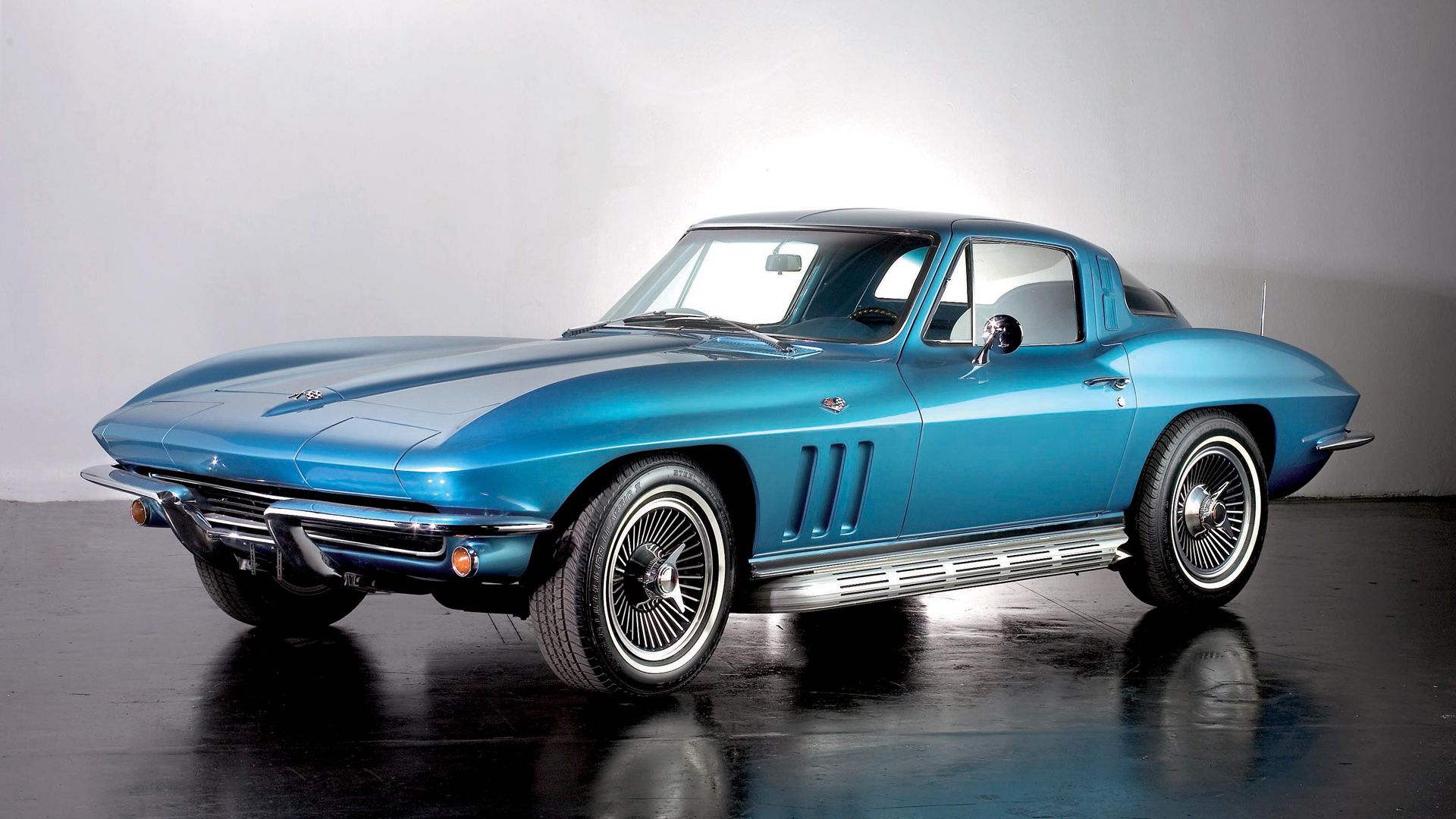
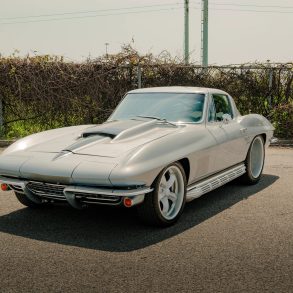
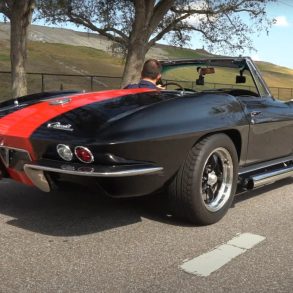
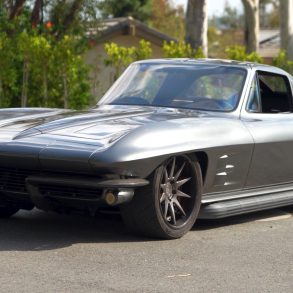
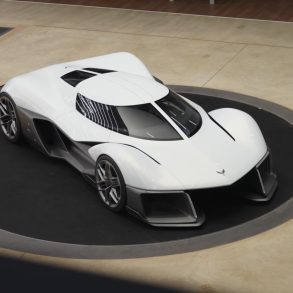
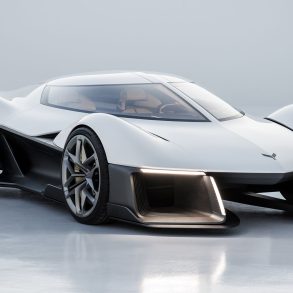

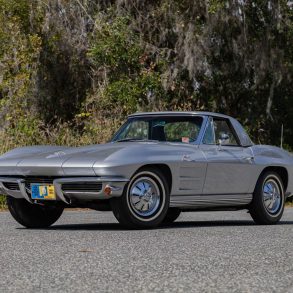
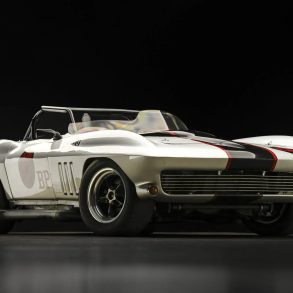

Great article, l really enjoyed it.
Nice advice but they are not C2’s! They are Mid years or Sting Rays! Why? Because between 1953 and 56 there is a serious body charge. That would make them C3s.
Also back in the days because they came out in the middle of the decade Mid year. This c2 crap came with the c4s as they ran out of cool names for Corvettes like Sting Rays 63-67 and Sharks 68-82!
Very informative. Only one glitch. 63 to 67 cars had no t tops. I bought a 73 coupe six years. Took a floor jack to look underneath. My car is from north Jersey since new. However, it was kept inside all the time. The frame and birdcage perfect. Checking the birdcage at front body mount easy. Remove one long Phillips screw at each kick panel. Mine still had most of the factory green primer on it. Do your homework.